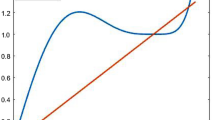Abstract
This paper presents a novel algorithm to compute real-valued fast Fourier transform (RFFT) that is canonic with respect to the number of signal values. A signal value can correspond to a purely real or purely imaginary value, while a complex signal consists of 2 signal values. For an N-point RFFT, each stage needs not compute more than N signal values, since the degrees of freedom of the input data are N. Any more than N signal values computed at any stage is inherently redundant. In order to reduce the redundant samples, a sample removal lemma, and two types of twiddle factor transformations are proposed: pushing and modulation. We consider 4 different cases for an N = P × Q point canonic RFFT: 1) P is odd, Q is odd; 2) P is odd, Q is even; 3) P is even, Q is odd; and 4) P is even, Q is even. No twiddle factor transformation is required when P is odd. It is shown that the number of twiddle factors can be reduced by performing modulation transformation when P is even and Q is odd, while 2 real twiddle factor operations are pushed to 1 complex twiddle factor operation when P and Q are both even. Canonic RFFT for any composite length can be computed by applying the proposed algorithm recursively. Performances of different RFFTs are also discussed in this paper. The major advantages of the canonic RFFTs are that they require the least number of butterfly operations, lead to more regular sub-blocks in the data-flow, and only involve real datapath when mapped to architectures. However, we also show that canonic RFFTs may not be desirable when taking the cost of twiddle factor operations as the major consideration.






















Similar content being viewed by others
References
Ayinala, M., Brown, M., & Parhi, K.K. (2012). Pipelined parallel FFT architectures via folding transformation. IEEE Transactions on Very Large Scale Integration (VLSI) Systems, 20(6), 1068–1081.
Ayinala, M., Lao, Y., & Parhi, K.K. (2013). An in-place FFT architecture for real-valued signals. IEEE Transactions on Circuits and Systems II: Express Briefs, 60(10), 652–656.
Ayinala, M., & Parhi, K.K. (2013). FFT architectures for real-valued signals based on radix- 23 and radix- 24 algorithms. IEEE Transactions on Circuits and Systems I: Regular Papers, 60(9), 2422–2430.
Baas, B.M. (1999). A low-power, high-performance, 1024-point FFT processor. IEEE Journal of Solid-State Circuits, 34(3), 380–387.
Bergland, G.D. (1968). A fast Fourier transform algorithm using base 8 iterations. Mathematics of Computation, 22(102), 275–279.
Bowers, K.J., Lippert, R.A., Dror, R.O., & Shaw, D.E. (2010). Improved twiddle access for fast Fourier transforms. IEEE Transactions on Signal Processing, 58(3), 1122–1130.
Chi, H.F., & Lai, Z.H. (2005). A cost-effective memory-based real-valued FFT and hermitian symmetric IFFT processor for DMT-based wire-line transmission systems. In IEEE International symposium on circuits and systems (ISCAS) (pp. 6006–6009).
Cooley, J.W., & Tukey, J.W. (1965). An algorithm for the machine calculation of complex Fourier series. Mathematics of computation, 19(90), 297–301.
Duhamel, P., & Hollmann, H. (1984). Split radix FFT algorithm. Electronics Letters, 20(1), 14–16.
Garrido, M., Parhi, K.K., & Grajal, J. (2009). A pipelined FFT architecture for real-valued signals. IEEE Transactions on Circuits and Systems I: Regular Papers, 56(12), 2634–2643.
He, S., & Torkelson, M. (1996). A new approach to pipeline FFT processor. In: Proceedings of the 10th international parallel processing symposium (IPPS’96) (pp. 766–770).
Hu, Z., & Wan, H. (2005). A novel generic fast Fourier transform pruning technique and complexity analysis. IEEE Transactions on Signal Processing, 53(1), 274–282.
Lao, Y., & Parhi, K.K. (2015). Canonic real-valued radix- 2n FFT computations. In 49th Asilomar conference on signals, systems and computers (pp. 441–446).
Lao, Y., & Parhi, K.K. (2016). Data-canonic real FFT flow-graphs for composite lengths. In Proceedings of IEEE International workshop on signal processing Systems (SiPS) (pp. 189–194).
Medina-Melendrez, M., Arias-Estrada, M., & Castro, A. (2009). Input and/or output pruning of composite length FFTs using a DIf-DIT transform decomposition. IEEE Transactions on Signal Processing, 57(10), 4124–4128.
Meher, P.K., Mohanty, B.K., Patel, S.K., Ganguly, S., & Srikanthan, T. (2015). Efficient VLSI architecture for decimation-in-time fast Fourier transform of real-valued data. IEEE Transactions on Circuits and Systems I: Regular Papers, 62(12), 2836–2845.
Milder, P.A., Franchetti, F., Hoe, J.C., & Püschel, M. (2010). Hardware implementation of the discrete fourier transform with non-power-of-two problem size. In 2010 IEEE International conference on acoustics speech and signal processing (ICASSP) (pp. 1546–1549).
Nussbaumer, H.J. (2012). Fast Fourier transform and convolution algorithms (Vol. 2). Springer Science & Business Media.
Oppenheim, A.V., Schafer, R.W., & Buck, J.R. (1989). Discrete-time signal processing. Prentice-hall Englewood Cliffs.
Parhi, M., Lao, Y., & Parhi, K.K. (2014). Canonic real-valued FFT structures. In 48th Asilomar conference on signals, systems and computers (pp. 1261–1265).
Salehi, S.A., Amirfattahi, R., & Parhi, K.K. (2013). Pipelined architectures for real-valued FFT and hermitian-symmetric IFFT with real datapaths. IEEE Transactions on Circuits and Systems II: Express Briefs, 60(8), 507–511.
Singleton, R.C. (1969). An algorithm for computing the mixed radix fast Fourier transform. IEEE Transactions on Audio and Electroacoustics, 17(2), 93–103.
Sorensen, H.V., Jones, D.L., Heideman, M., & Burrus, C.S. (1987). Real-valued fast Fourier transform algorithms. IEEE Transactions on Acoustics Speech and Signal Processing, 35(6), 849–863.
Tolimieli, R., An, M., & Lu, C. (2013). Algorithms for discrete Fourier transform and convolution. Springer Science & Business Media.
Van Loan, C. (1992). Computational frameworks for the fast Fourier transform (Vol. 10). SIAM.
Voronenko, Y., & Puschel, M. (2009). Algebraic signal processing theory: Cooley–Tukey type algorithms for real DFTs. IEEE Transactions on Signal Processing, 57(1), 205–222.
Wang, L., Zhou, X., Sobelman, G.E., & Liu, R. (2012). Generic mixed-radix FFT pruning. IEEE Signal Processing Letters, 19(3), 167–170.
Yin, X., Yu, F., & Ma, Z. (2016). Resource-efficient pipelined architectures for radix-2 real-valued FFT with real datapaths. IEEE Transactions on Circuits and Systems II: Express Briefs.
Author information
Authors and Affiliations
Corresponding author
Rights and permissions
About this article
Cite this article
Lao, Y., Parhi, K.K. Canonic Composite Length Real-Valued FFT. J Sign Process Syst 90, 1401–1414 (2018). https://doi.org/10.1007/s11265-017-1296-9
Received:
Revised:
Accepted:
Published:
Issue Date:
DOI: https://doi.org/10.1007/s11265-017-1296-9




